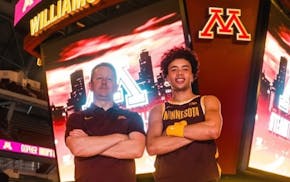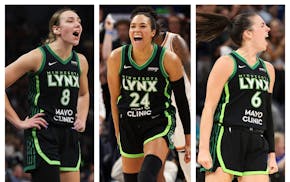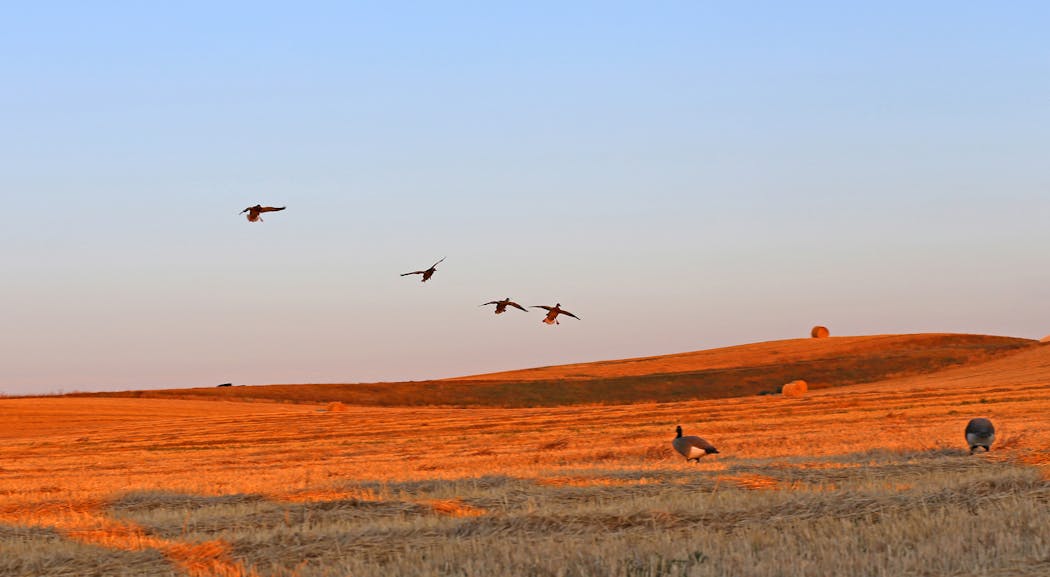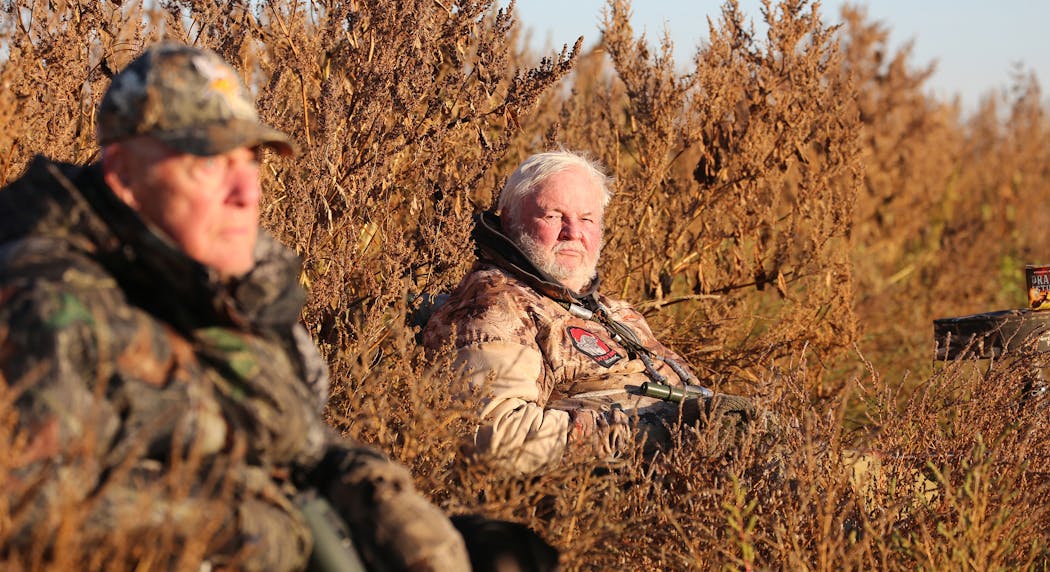WESTERN NORTH DAKOTA – Bud Grant had seen moons as full as the one that hung in the otherwise dark sky on a recent early morning, but few that were bigger, rounder or brighter.
Bouncing in his truck over a harvested barley field, the retired Vikings coach peered into the shadowy edges of the vehicle's headlights for the wetland near which he and others with him would hunt.
Now 93 years of age, Grant has been retired from football for more than three decades. He's lived longer than he thought he would, and all but a handful of his close friends are dead. But of regrets, he has none.
"I love every minute of this," Grant said. "Just to be here is enjoyable."
Alert and keen for the sun to bruise the eastern sky, foreshadowing the prairie's first duck flights, Grant, with two fake knees and a cane-assisted gait that befits his age, is as happy, it seems, as the proverbial lark.
This was the opening of North Dakota's nonresident duck hunting season, and Grant and his partner, Pat Smith, were guests of their friends, Mark and Penny Hamilton of Minot, N.D.
Kindred spirits, Grant and Mark Hamilton met in the mid-1980s when the latter asked Grant to travel to Canada to speak to the Saskatchewan Wildlife Federation.
"I said I'd speak if I could go hunting while I was there," Grant said.
In the years since, Grant has become a regular autumn visitor to North Dakota, where he is hosted by the Hamiltons, whose log home graces a convergence of tree-filled draws that divide the prairie starkly. With a museum's worth of taxidermied mementos, the home's decorating motif is hunting and more hunting.
Now, as night yields grudgingly to an unusually still North Dakota morning, a few dozen decoys have been spread into the field, and Grant, who sits in a type of lawn chair whose convertible top can be flipped open when he wants to shoot, has tucked in with Smith against giant barley bales that will nourish pastured cattle in the coming cold winter.
Appearing first, high overhead, is a smattering of geese. Famous as a coach for his sideline stoicism, Grant lifts his eyes toward the honk, honk of the big birds long enough to calculate their distance and direction. Then without comment or movement, he shifts his focus to a pintail duck that darts through the decoys and disappears.
"I'm not a bird watcher," Grant will say. "But I am a bird observer. Bluebirds. Swallows. Wrens. Blackbirds. Crows. Seagulls. And, of course, ducks. I'm interested in all of them."
As a kid growing up in Superior, Wis., while delivering newspapers door to door, Grant's curiosity was piqued by the fittings of sparrows and the comings and goings of barn pigeons. He had fashioned a slingshot from a willow branch, using the tongue of an old shoe for the primitive weapon's pouch, and as boys often do, soon enough was launching rocks in the birds' direction.
Later, at age 14, with a shotgun, he felled the first flying bird he targeted.
"My dad was not a big hunter, but he was a gregarious guy who was invited once to tag along with some friends on a grouse hunt, and bring me along," Grant said. "Later, Dad's friends said to him, 'Why don't you let the boy carry a gun?' and Dad said, 'We don't have a gun for him.' Well, one of the men gave me his gun and the first grouse — this was a sharptail, which we used to have in northwest Wisconsin — that got up in front of me, I shot on the wing.
"Afterward, in a tavern where the men gathered, they extolled my prowess as a hunter, and said my grouse was the biggest one taken that day. But, of course, all grouse are the same size."
Grant was still peddling papers when he bought a shotgun of his own for $5, and in October he'd stuff the single-shot 12 gauge Mossberg into his paper-route sack and ride the city bus to the Lake Superior shoreline. There he'd watch bluebills, the area's dominant duck, trade back and forth, and he'd occasionally crack off a round.
"I spent a lot of time by myself as a kid just watching ducks and trying to get close to them," Grant said. "Then one day a mallard came by, and mallards on Lake Superior were very rare. I took a shot and it went down awkwardly on the other side of a small bay. I recovered it and stuffed it into my paper bag, along with my gun, and took the bus home."
These many years later, Grant's eyesight has diminished, and he isn't the deadeye he once was. Oftentimes he depends on Smith, who is also a hunter, to alert him about incoming birds.
"Pat might say, 'There they are!' and I'll say, 'Where?' and she'll say, 'Right in front of you!' " Grant said. "But it doesn't bother me. It's part of the aging process."
Keen eyesight was one reason Grant was MVP of the Gophers basketball team during his 1946-49 tenure at the U. He also was a two-time All-Big Ten receiver on the football team and the leading hitter as a freshman on the baseball team.
Grant was named the university's top athlete in the first half of the last century, topping Bronko Nagurski and Bruce Smith for the honor.
"The best receivers I coached in Winnipeg and with the Vikings didn't see passes coming the way people with average eyesight see them," he said. "They see so well that they essentially slow the ball down as it comes toward them, allowing them to time their catches in ways most people can't.
"I was talking to Ted Williams once, the baseball great, who had better than 20-10 vision. He said he could see the seams of a baseball turn when it came toward him, which is why he was such a great hitter and why in World War II and later in the Korean War he was also a great fighter pilot."
Higher in the sky now, the midmorning sun had replaced the moon over the North Dakota prairie.
Production-wise, the outing had been a bust, with just two mallards on the ground.
"Still, it was a great morning," Grant said.
Top: North Dakota's vast western prairies and croplands have been visited regularly each fall by Bud Grant during the 35 years or so since he retired as Vikings coach. Below: Mark Hamilton, right, of Minot, N.D., is a longtime friend and hunting partner of Bud Grant's. The two have traveled to Africa together, among other places, to hunt.Grant's retirement from coaching at age 58 surprised everyone but him and his late wife, Pat, who died of Parkinson's disease in 2009.
"We had a plan before we got married to have four kids," Grant said. "Then, after we had four, we decided to have a couple more. Pat was a great influence on the kids and she insisted they all go to college, which they did, and they all graduated with no student loans. That was our mission, we accomplished it, and the day our youngest, Dan, graduated from St. John's, I knew my working days were over. It was time to do the things I liked to do."
The things that Grant "liked to do" hadn't been entirely set aside during his playing and coaching days.
Heralded for his triumphs at the U, as well as with the world champion Minneapolis Lakers pro basketball team, the Philadelphia Eagles of the NFL, the Winnipeg Blue Bombers of the Canadian Football League and the Vikings, Grant at each stop played hooky whenever he could.
Sometimes he'd hunt. Sometimes he'd fish. Other times he'd train a raven to come to his call and sit on his shoulder. Or play fetch with one of his Labrador retrievers.
Hamilton isn't sure whether Grant is more intrigued by his day job or by his adventures outdoors.
"I remember Bud was here in North Dakota to hunt ducks in the fall of 2000," Hamilton said. "We had a great morning, killing 10 drake mallards and two pintails with 12 shots. Afterward we returned to my house to watch the Gophers play Ohio State at Columbus.
"It was a game the Gophers won for the first time in 51 years at Columbus, and it was the last year Ray Christensen called the Gopher games. Throughout the game, Bud didn't say one thing about him playing, and starring, in the 1949 game the Gophers won at Columbus. Finally, at the end of the game, when Christensen showed an old clip of Bud running back an interception for a touchdown in the 1949 game, I said, 'You played in that game?' All he said was, 'Yup, that's me.' "
Bob Lessard, 89, has hunted and fished with Grant since 1967, when Grant moved from Winnipeg to the Twin Cities to coach the Vikings.
"He'll talk all day about birds and deer and ravens, especially ravens and how smart they are," Lessard said. "And he knows the names of every brook trout creek between the Twin Cities and his cabin in Wisconsin. But unless he's asked about football, he doesn't talk about it."
Top: Bud Grant and his Labrador retriever, Lilly, eyed the sky. Below: Ducks seen on the opening weekend for non-resident North Dakota hunters included drake mallards, like these, as well as pintails, gadwall and wigeon.Grant's 2013 biography is titled "I Did It My Way." A more recent retrospective is called "I've Been Lucky.''
Both are true.
Except for the death of his wife and the passing of his son, Bruce, in 2018, Grant's memories of his long life are almost entirely positive. Positive as well is his relationship with Smith, a good-humored partner who isn't afraid to audible when she suspects the coach has made a wrong call.
Still, at 93, Grant bears the burden of a changed world. Football is alive and well, and he could watch a game on TV almost any day of the week, if he wanted to.
But he can't look out his cabin window and see the purple martins that once returned to his yard every spring, or the bluebirds or the swallows or even the crows.
"I used to come to North Dakota and love the sound of meadowlarks," Grant said. "Now I never hear a meadowlark. The blackbirds are also gone. I can remember when we had to wait until all the blackbirds left a slough before we could hunt ducks, there were so many of them. There were a lot of ducks then, too.
"Now, there aren't many blackbirds or ducks. I don't know if we're poisoning them or what's happening. The same with insects. They're just not here. And that's happened in my lifetime."
On the second morning of hunting, a moon-brightened sky again welcomed Grant, Smith and Hamilton, along with local friends Scott and Trevor Tranby.
Ducks were again fairly scarce, but by 10 a.m., when the day had turned warm and the birds had stopped flying, the five hunters had somersaulted 10 mallards.
Grant was asked if he wanted to pick up the decoys and go for breakfast.
He said he was good where he was.
"I'm not a shooter," he will say. "I can't ever remember shooting a clay pigeon. That's fine if you want to do it. But the part of hunting I enjoy is the anticipation, the planning, the participation, the birds you see and the company you keep.
"I don't have to kill ducks to enjoy it. Just being able to participate is invaluable."

Smooth shooter from East Ridge commits to Gophers men's basketball team

Wild roster breakdown: Who stays, and who goes?

As the Loons prepare to face Lionel Messi and Inter Miami, what's this circus all about, anyway?

Twins power-hitting prospect drawing big-league attention






